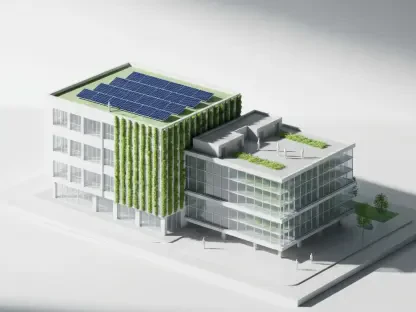In the global quest for energy efficiency, the warm edge spacer market is emerging as a significant player, projected to expand its market value by substantial margins over the next decade. Beginning with a valuation of $1.15 billion, the market is anticipated to grow to $1.9 billion by 2035, marking a compound annual growth rate (CAGR) of 5.1%. This surge is primarily fueled by increasingly stringent energy regulations worldwide and a growing preference for sustainable building practices. Warm edge spacers, pivotal in enhancing the thermal efficiency of glazing systems, cater to this rising demand.
Market Dynamics
Key Growth Drivers
The primary contributor to the increasing adoption of warm edge spacers is the mounting global emphasis on energy efficiency, prompting countries to adopt stricter regulations. These spacers are engineered to enhance the thermal performance of windows by minimizing energy loss, an attribute that aligns perfectly with the goals of modern green building standards. A notable trend is the sustained popularity of flexible spacers, appreciated for their exceptional thermal performance, while plastic/metal hybrids are gaining traction, particularly in commercial applications. Their capability to balance efficiency with durability has proven advantageous in office buildings and other commercial structures.
Additionally, technological advancements have paved the way for innovative solutions in the market, with silicone-based formulations standing out. These formulations are revolutionizing the industry with their unique properties, adapting to various environmental conditions, and offering benefits like improved durability and temperature resistance. As building codes evolve toward greener practices, warm edge spacers have become indispensable. The demand for energy-efficient systems contributes significantly to the market’s upward trajectory, alongside the increasing adoption of smart glazing technologies for enhanced building automation.
Regional Performance
Geographically, different regions exhibit varied growth patterns in warm edge spacer adoption. North America maintains a leading position, accounting for 40-45% of market share, largely owing to initiatives like ENERGY STAR certifications that drive energy-conscious decisions. The market in this region benefits from established construction practices prioritizing energy-saving innovations, alongside strong consumer and governmental support for sustainable development practices. As a result, North America remains a stronghold for manufacturers focusing on advanced spacer products.
On the other hand, the Asia-Pacific region showcases remarkable growth potential, substantially outpacing other regions with a CAGR exceeding 6%. This growth is propelled by burgeoning construction activities and an increasing emphasis on sustainable building requirements in countries like China and India. These nations are investing substantial resources in upgrading building standards to align with global sustainability goals, subsequently boosting the demand for effective thermal management solutions like warm edge spacers. Meanwhile, Europe continues to hold a significant market share, driven by strict environmental mandates and government incentives promoting energy-efficient materials.
Technological and Commercial Trends
Innovations and Developments
The warm edge spacer industry is currently driven by technological innovations aimed at maximizing lifespan and performance. Recent advancements in low-conductivity materials have introduced new possibilities for manufacturers, enabling them to create spacers that excel in thermal efficiency while being environmentally friendly. The integration of such advancements with smart glazing technologies is setting new industry benchmarks, offering benefits like optimized energy management and reduced carbon emissions. These improvements align with global sustainability targets, reinforcing the industry’s role in future-proof construction practices.
In the commercial sphere, the market sees a notable trend of rising demand from businesses focused on reducing their carbon footprint. With an impressive CAGR of 8.7%, the commercial segment emerges as a key growth area, as organizations increasingly adopt sustainable policies. These moves are largely motivated by corporate social responsibility goals and consumer expectations for environmentally conscious practices. Buildings employing advanced spacer technology stand to significantly lower their energy consumption, fulfilling both economic and ecological objectives.
End-User and Market Impact
The building and construction sector commands the largest market share, estimated at 40-50%, due to the direct influence of energy mandates. This sector’s growth is fueled by the increasing adoption of energy-efficient materials in both new constructions and retrofits. Governments and private sector stakeholders are consistently incentivizing the use of high-performance thermal solutions, driving market demand. In addition, there’s a growing preference for materials that contribute to overall energy savings and reduce utility costs for end-users.
Looking further into market dynamics, developing regions like Latin America and the Middle East & Africa are starting to emerge as potential markets for warm edge spacer technologies. These areas are witnessing increased construction activities, coupled with rising awareness of energy efficiency benefits. As these regions grow economically, there is an enhanced focus on sustainable development, creating fresh opportunities for innovation and expansion in the warm edge spacer market. These trends underscore a broadening perspective and the market’s responsiveness to varying global demands.
Future Prospects
In the global drive toward greater energy efficiency, the warm edge spacer market is gaining prominence as a key contributor. It is poised for significant growth, with its market value expected to rise markedly in the coming decade. Currently valued at $1.15 billion, projections suggest that this market will increase to $1.9 billion by 2035. This growth trajectory corresponds to a compound annual growth rate (CAGR) of 5.1%. The surge in demand is largely driven by increasingly stringent energy regulations worldwide and a growing emphasis on sustainable building standards. Warm edge spacers play a crucial role in optimizing the thermal performance of glazing systems, which makes them essential in meeting these evolving energy requirements. As buildings aim for better energy efficiency, the significance of warm edge spacers continues to rise. They reduce thermal bridging and improve overall insulation, aligning with global trends toward reducing energy consumption and environmental impact, creating a promising outlook for the industry.









